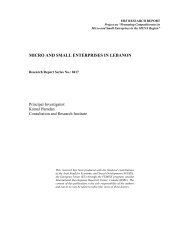local employment growth in the coastal area of tunisia - Economic ...
local employment growth in the coastal area of tunisia - Economic ...
local employment growth in the coastal area of tunisia - Economic ...
Create successful ePaper yourself
Turn your PDF publications into a flip-book with our unique Google optimized e-Paper software.
1. Introduction<br />
Nowadays regional development <strong>in</strong> Tunisia represents one <strong>of</strong> <strong>the</strong> ma<strong>in</strong> development goals.<br />
The Tunisian revolution was a reaction to regional disparities on economical and <strong>employment</strong><br />
opportunities. S<strong>in</strong>ce <strong>the</strong> mid-1980s, <strong>the</strong> previous regime has made a structural adjustment<br />
program characterized by more privatization and economic open<strong>in</strong>g (Ayadi et al., 2007)<br />
which has been associated to an upgrad<strong>in</strong>g program (“mise a niveau” and <strong>in</strong>dustrial<br />
modernization), <strong>in</strong>tended to re<strong>in</strong>force <strong>the</strong> potential <strong>of</strong> firm performance and <strong>the</strong>ir<br />
technological and market<strong>in</strong>g capabilities (Diop, 2008). However <strong>the</strong>se policies affected <strong>the</strong><br />
spatial structure <strong>of</strong> economic activities, it has <strong>in</strong>creased <strong>in</strong>equalities <strong>in</strong> economic performance<br />
and <strong>employment</strong> opportunities between <strong>coastal</strong> and <strong>in</strong>terior regions. More than 90% <strong>of</strong> <strong>the</strong><br />
total <strong>employment</strong> is still generated <strong>in</strong> <strong>the</strong> <strong>coastal</strong> part <strong>of</strong> <strong>the</strong> country (Dlala, 1997; Amara,<br />
2009).<br />
Krugman (1991) shows that “decl<strong>in</strong>e <strong>in</strong> transport costs <strong>in</strong>crease <strong>the</strong> economies <strong>of</strong> scale and<br />
<strong>the</strong> mobility <strong>of</strong> <strong>the</strong> specialized labor, re<strong>in</strong>force agglomeration <strong>of</strong> firms and extend regional<br />
disparities”. Regional disparities are associated with <strong>the</strong> <strong>in</strong>teraction between market or<br />
agglomeration forces and governmental policies. World Bank Report stands that, “Markets<br />
favor some places over o<strong>the</strong>rs, some places-cities, <strong>coastal</strong> <strong>area</strong>s, and connected countries are<br />
favored by producers” (World Bank, 2009). The evaluations <strong>of</strong> spatial spillovers affect<strong>in</strong>g<br />
firms’ locations choices are crucial if we look for <strong>the</strong> identification <strong>of</strong> <strong>local</strong> <strong>employment</strong><br />
<strong>growth</strong> factors.<br />
World Development Report 2009: Reshap<strong>in</strong>g <strong>Economic</strong> Geography discusses how<br />
governments can tailor policies to <strong>in</strong>tegrate <strong>area</strong>s with<strong>in</strong> nations, while reduc<strong>in</strong>g poverty<br />
everywhere. Spatially targeted <strong>in</strong>terventions are just a small part <strong>of</strong> what government can do<br />
to help places that are not do<strong>in</strong>g well (World Bank, 2009). We will discuss <strong>in</strong> this paper about<br />
<strong>the</strong> <strong>in</strong>fluence <strong>of</strong> geography on economic opportunity, to analyze <strong>the</strong> drivers <strong>of</strong> <strong>the</strong> changes <strong>in</strong><br />
<strong>employment</strong>s opportunities and identify market forces that deliver convergences. We will<br />
propose some <strong>in</strong>tegration economical pr<strong>in</strong>cipals to guide policy makers.<br />
Several academic papers have focused on <strong>local</strong> <strong>employment</strong> <strong>growth</strong> determ<strong>in</strong>ants <strong>in</strong> Tunisia<br />
(see for example Dlala, 2007 and Ben Ayed Mouelhi, 2007). Whereas, little attention has<br />
been given to spatial effects on <strong>employment</strong> <strong>growth</strong>, <strong>the</strong>y ignore firm location effects.<br />
Interests <strong>of</strong> previous studies are largely focused on a firm’s characteristics regardless <strong>of</strong> <strong>the</strong>ir<br />
location, ignor<strong>in</strong>g factors that might affect a firm’s location choice such as peer effect,<br />
<strong>in</strong>teraction between firms, spillovers, and spatial externalities. This paper attempts to fill this<br />
gap. We attempt to analyze determ<strong>in</strong>ants <strong>of</strong> <strong>local</strong> <strong>employment</strong> <strong>growth</strong>, consider<strong>in</strong>g both its<br />
spatial and dynamic aspects. Neighborhoods matter, a region’s prosperity is sooner or later<br />
shared with those nearby. We found that, as production cost <strong>in</strong>creases <strong>in</strong> <strong>the</strong> governorate <strong>of</strong><br />
Tunis, Sousse and Sfax, some activities are de<strong>local</strong>ized <strong>in</strong> specific neighbor<strong>in</strong>g governorates:<br />
Zaghouan, Nabeul and Mounastir, but never <strong>in</strong> fur<strong>the</strong>r ones. Thus we will identify <strong>the</strong> market<br />
forces, depend<strong>in</strong>g on economic geography, that best support <strong>the</strong> concentration <strong>of</strong> <strong>employment</strong><br />
opportunities, <strong>the</strong>refore help<strong>in</strong>g to identify new ideas for convergence <strong>of</strong> <strong>employment</strong>s levels<br />
across different locations. On <strong>the</strong> o<strong>the</strong>r hand, when we dist<strong>in</strong>guish between <strong>in</strong>dustrial sectors<br />
our results show that spillovers are significantly effective only with<strong>in</strong> a range <strong>of</strong> 15 km for<br />
high -tech <strong>in</strong>dustries aga<strong>in</strong>st 50 km for low-tech. Our econometric result stand that<br />
agglomeration and education have positive effect on <strong>the</strong> <strong>local</strong> <strong>employment</strong> manufactur<strong>in</strong>g<br />
<strong>growth</strong>. However, competition has a negative effect <strong>in</strong> <strong>the</strong> first year, but positive one on <strong>the</strong><br />
long run.<br />
The rest <strong>of</strong> <strong>the</strong> paper is organized as follows. In <strong>the</strong> next section we will consider <strong>the</strong><br />
Tunisian context giv<strong>in</strong>g more illustration on spatial <strong>in</strong>equalities. Section 3 represents our<br />
spatial dynamic econometric model, consider<strong>in</strong>g <strong>the</strong> appropriate covariates and estimation<br />
2

















